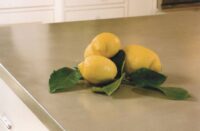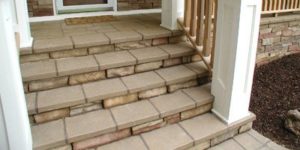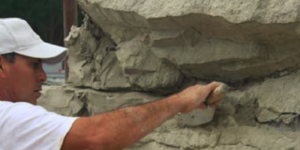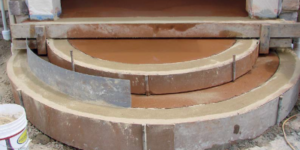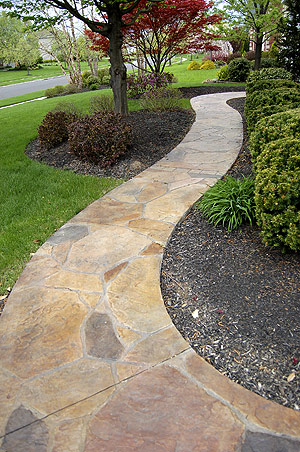 |
 |
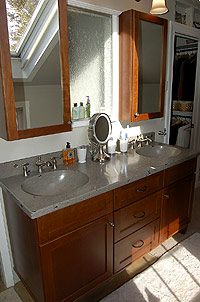 |
 |
Gerry Maurer of Liquid Stone Concrete Designs has a fancy for ferns. Instead of signing his outdoor works, he likes to leave his mark with an imprint of a fresh fern. He had considered making a stamp, he says, but he just couldn’t capture the beauty and crispness of the real thing. “A lot of times, I don’t even tell them about it. I let them find it on their own. It’s like a thank you.”
Maurer, who has been doing masonry work in Pennsylvania for close to 25 years, specialized in stone patios until rising prices for materials forced him to explore other avenues. About 10 years ago, when he was in his 30s, he discovered the world of decorative concrete. “I fell in love with what you could do with it,” he says. The work wasn’t nearly as labor intensive as using real stone, and the process was much more affordable for homeowners.
At about that same time, he returned to school to pursue a degree in architecture at Philadelphia College of Textiles & Science, now known as Philadelphia University. It was there he met and fell in love with his now-partner and wife, Elizabeth. Also a returning student, she was studying interior design.
“When I graduated, we decided Gerry would stop working for other contractors,” Elizabeth says. So in 1997, they founded GEM Enterprize, which subsequently morphed into Liquid Stone Concrete Designs in 2006.
“We’ve found a lot of decorative stamped-concrete people have no concrete background, and some have a concrete background but no artistic training,” Elizabeth says. “But with our experience, we’ve brought it all together to evolve this company and take it forward.”
Besides husband and wife, there are three full-time employees, including Arron Schopfer, who also holds a degree in architecture from Philadelphia University. Schopfer met the couple at college and has been with them since the beginning.
“Our training helps us understand the overall design of a project,” Gerry says. “We better understand clients and the direction they want to move in.”
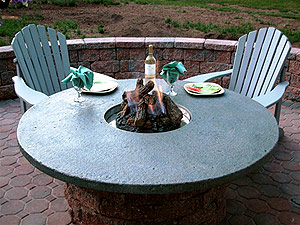 |
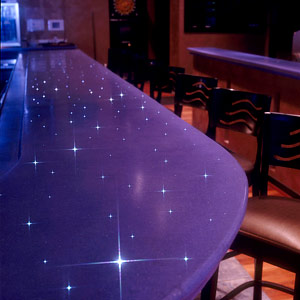 |
 |
 |
Elizabeth deals with the clients on a one-on-one basis, personally meeting with them, estimating costs and scheduling jobs. She also handles the books, advertising and marketing, leaving Gerry the time to focus on art and “technical stuff,” she says.In the beginning, the company concentrated on flatwork and foundations, but soon began dabbling in decorative concrete. More recently, stamping has been the bread and butter of the business, but that started to change about a year ago, Elizabeth says. “I’d say about 99 percent of our work involved stamping, staining and foundations, but now we’re getting more and more requests for concrete countertops.”In the area of Pennsylvania they live in, just north of Philadelphia, people want countertops that are as polished and refined as granite, Elizabeth says. “The types of countertops that are popular in California and New York City don’t fly here. For the most part, our clients want a very traditional look.”
Recently, Gerry Maurer and his crew poured a countertop that was not so traditional — one laden with fiber optics for a local bar — which garnered a lot of attention. In fact, he was one of six people invited to talk at the Concrete Countertop Industry Conference held in Charlotte, N.C., last October, where he addressed how to sell and place fiber optics.
 |
 |
 |
 |
And last spring, he and his crew made a countertop embedded with recycled glass as part of the 2007 Bucks County Designer House, a house that featured sustainable building products.Currently, he’s working on an interesting project that involves coloring and stamping a concrete floor in an old barn — “There are a lot of old barns up this way that people want to redo” — and then adding grout and polishing it. “Doing a 2-by-2 foot sample was one thing, but surfacing a 1,200-square-foot floor is another animal,” he says. “The whole trick is keeping the colors consistent.”
Maurer notes that he often blends different colors of color hardener to match existing brick and stonework in these old structures. “I would never dream of painting a color on,” he says, adding that a lot of contractors in his area do just that.
The contractor’s degree in fine woodworking, which he earned right out of high school, has proven to be very beneficial in creating intricate forms for countertops, he says. “Plus I make my own forms for edge details.”On the flip side, Maurer also relishes the challenge of free-form concrete placement. Although he hasn’t done a complete free-form patio yet, he has formed stepping stones off patios. “I set some grade pins for elevations and sculpted the concrete to form what I wanted it to look like,” he says about one of the jobs. “I stamped and colored the stones and used leaves to make it look like a large fossil.”
This coming year, he says, his company is going to explore more artistic applications of concrete with furniture and fixtures for both interior and exterior uses.
 |
 |
But for now, Elizabeth and Gerry’s latest venture is a showroom that opened Oct. 1, 2007, in an old Victorian-style building in Peddler’s Village in Lahaska, Pa. There, browsers and potential clients can see samples of the company’s handiwork, from sinks and countertops to acid-stained floors and overlays. The location is perfect, Elizabeth says, as the village is one of the state’s busiest tourist destinations.
Gerry’s advice to others in the decorative concrete business? “Sample, sample, sample and practice, practice, practice — and not on your client,” he says. “Show your clients samples and not just pictures. And, above all, know your product.”
For that, Elizabeth advises, go to school and learn all you can about concrete. “You need to understand the basic material to really work the medium,” she says. And take a class or two in design to give your work some “pizzazz and pop” instead of slapping down the same old squares and rectangles.
Also, stand firm and insist on being paid for your time and effort. “So many times contractors and artisans don’t get paid for their knowledge,” Gerry says. “I know I’ve invested a lot of money on training and continue to train and go to shows. All that adds up. I think you should be paid what you’re worth.”


